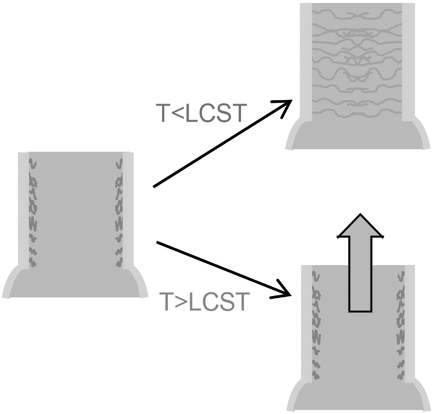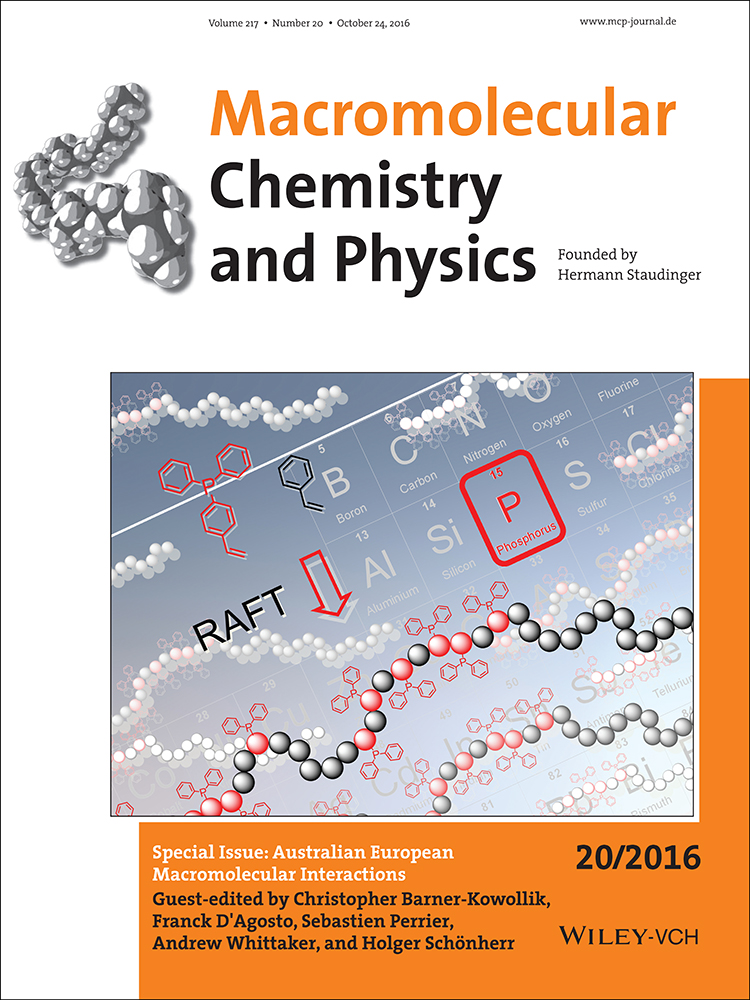Temperature-Controlled Antimicrobial Release from Poly(diethylene glycol methylether methacrylate)-Functionalized Bottleneck-Structured Porous Silicon for the Inhibition of Bacterial Growth
Stephanie Müller
Physical Chemistry I, Department of Chemistry and Biology & Research Center of Micro and Nanochemistry and Engineering (Cμ), University of Siegen, Adolf-Reichwein-Str. 2, 57076 Siegen, Germany
Search for more papers by this authorAlex Cavallaro
School of Engineering, University of South Australia, Mawson Lakes, SA, 5095 Australia
Search for more papers by this authorKrasimir Vasilev
School of Engineering, University of South Australia, Mawson Lakes, SA, 5095 Australia
Search for more papers by this authorCorresponding Author
Nicolas H. Voelcker
Future Industries Institute, University of South Australia, Mawson Lakes Boulevard, 5095 Adelaide, Australia
E-mail: [email protected], [email protected]Search for more papers by this authorCorresponding Author
Holger Schönherr
Physical Chemistry I, Department of Chemistry and Biology & Research Center of Micro and Nanochemistry and Engineering (Cμ), University of Siegen, Adolf-Reichwein-Str. 2, 57076 Siegen, Germany
E-mail: [email protected], [email protected]Search for more papers by this authorStephanie Müller
Physical Chemistry I, Department of Chemistry and Biology & Research Center of Micro and Nanochemistry and Engineering (Cμ), University of Siegen, Adolf-Reichwein-Str. 2, 57076 Siegen, Germany
Search for more papers by this authorAlex Cavallaro
School of Engineering, University of South Australia, Mawson Lakes, SA, 5095 Australia
Search for more papers by this authorKrasimir Vasilev
School of Engineering, University of South Australia, Mawson Lakes, SA, 5095 Australia
Search for more papers by this authorCorresponding Author
Nicolas H. Voelcker
Future Industries Institute, University of South Australia, Mawson Lakes Boulevard, 5095 Adelaide, Australia
E-mail: [email protected], [email protected]Search for more papers by this authorCorresponding Author
Holger Schönherr
Physical Chemistry I, Department of Chemistry and Biology & Research Center of Micro and Nanochemistry and Engineering (Cμ), University of Siegen, Adolf-Reichwein-Str. 2, 57076 Siegen, Germany
E-mail: [email protected], [email protected]Search for more papers by this authorAbstract
Bacterial infections in wounds slow down the healing process and lead to increased morbidity in affected patients. Polymer coatings on porous membranes were investigated, which facilitate the in situ detection and treatment of, e.g., Escherichia coli and Staphylococcus aureus infections. The theranostic approach relies on the thermoresponsive polymer poly(diethylene glycol methylether methacrylate) (PDEGMA). The increase of the wound temperature due to infection is targeted in this proof of concept study for triggering the release of the fluorescent antibiotic levofloxacin from bottle-shaped porous silicon (pSi) membranes capped with PDEGMA brushes. Below their lower critical solution temperature (LCST) the PDEGMA brushes are expanded and the levofloxacin release is significantly retarded. By contrast, above the LCST the PDEGMA brushes collapse and levofloxacin is released rapidly, which is detectable in solution owing to its fluorescence properties. The concomitant inhibition of bacterial growth agrees favorably with the drug release determined by fluorescence spectroscopy.
Supporting Information
As a service to our authors and readers, this journal provides supporting information supplied by the authors. Such materials are peer reviewed and may be re-organized for online delivery, but are not copy-edited or typeset. Technical support issues arising from supporting information (other than missing files) should be addressed to the authors.
| Filename | Description |
|---|---|
| macp201600099-sup-0001-S1.pdf2 MB | Supplementary |
Please note: The publisher is not responsible for the content or functionality of any supporting information supplied by the authors. Any queries (other than missing content) should be directed to the corresponding author for the article.
References
- 1K. Kirketerp-Møller, P. Ø. Jensen, M. Fazli, K. G. Madsen, J. Pedersen, C. Moser, T. Tolker-Nielsen, N. Høiby, M. Givskov, T. Bjarnsholt, J. Clin. Microbiol. 2008, 46, 2717.
- 2 Principles of Bacterial Detection: Biosensors, Recognition Receptors and Microsystems (Ed: M. Zourob), Springer, New York 2008.
10.1007/978-0-387-75113-9 Google Scholar
- 3P. Goldschmidt, S. Degorge, L. Merabet, C. Chaumeil, PLoS ONE 2014, 9, e94886.
- 4a) G. Baier, A. Cavallaro, K. Vasilev, V. Mailänder, A. Musyanovych, K. Landfester, Biomacromolecules 2013, 14, 1103; b) M.-M. Sadat Ebrahimi, Y. Voss, H. Schönherr, ACS Appl. Mater. Interfaces 2015, 7, 20190; c) S. Haas, N. Hain, M. Raoufi, S. Handschuh-Wang, T. Wang, X. Jiang, H. Schönherr, Biomacromolecules 2015, 16, 832.
- 5A. Mutalib, D. Losic, N. H. Voelcker, Prog. Mater. Sci. 2013, 58, 636.
- 6a) F. S. H. Krismastuti, W. L. A. Brooks, M. J. Sweetman, B. S. Sumerlin, N. H. Voelcker, J. Mater. Chem. B 2014, 2, 3972; b) F. S. H. Krismastuti, H. Bayat, N. H. Voelcker, H. Schönherr, Anal. Chem. 2015, 87, 3856.
- 7S. J. P. McInnes, N. H. Voelcker, Future Med. Chem. 2009, 1, 1051.
- 8S. Simovic, D. Losic, K. Vasilev, Chem. Commun. 2010, 46, 1317.
- 9J. Wu, M. J. Sailor, Adv. Funct. Mater. 2009, 19, 733.
- 10S. J. P. McInnes, E. J. Szili, S. A. Al-Bataineh, J. Xu, M. E. Alf, K. K. Gleason, R. D. Short, N. H. Voelcker, ACS Appl. Mater. Interfaces 2012, 4, 3566.
- 11C. Sugnaux, L. Lavanant, H.-A. Klok, Langmuir 2013, 29, 7325.
- 12G. W. de Groot, M. G. Santonicola, K. Sugihara, T. Zambelli, E. Reimhult, J. Vörös, G. J. Vancso, ACS Appl. Mater. Interfaces 2013, 5, 1400.
- 13M. Fierheller, R. G. Sibbald, Adv. Skin Wound Care 2010, 23, 369.
- 14R. B. Vasani, S. J. P. McInnes, M. A. Cole, A. Mutalib, A. V. Ellis, N. H. Voelcker, Langmuir 2011, 27, 7843.
- 15M. Szuwarzyński, L. Zaraska, G. D. Sulka, S. Zapotoczny, Chem. Mater. 2013, 25, 514.
- 16a) H. Vihola, A. Laukkanen, L. Valtola, H. Tenhu, J. Hirvonen, Biomaterials 2005, 26, 3055; b) M. A. Cooperstein, H. E. Canavan, Biointerphases 2013, 8, 19; c) T. Takezawa, Y. Mori, K. Yoshizato, Nat. Biotechnol. 1990, 8, 854.
- 17a) A. Hucknall, S. Rangarajan, A. Chilkoti, Adv. Mater. 2009, 21, 2441; b) S. Dey, B. Kellam, M. R. Alexander, C. Alexander, F. R. A. J. Rose, J. Mater. Chem. 2011, 21, 6883.
- 18S. Desseaux, H.-A. Klok, Biomacromolecules 2014, 15, 3859.
- 19S. Han, M. Hagiwara, T. Ishizone, Macromolecules 2003, 36, 8312.
- 20E. Wassel, PhD Thesis, University of Siegen 2015.
- 21E. Wassel, S. Jiang, Q. Song, S. Vogt, G. Nöll, H. Schönherr, Langmuir 2016, unpublished.
- 22a) J.-F. Lutz, A. Hoth, Macromolecules 2006, 39, 893; b) X. Laloyaux, E. Fautré, T. Blin, V. Purohit, J. Leprince, T. Jouenne, A. M. Jonas, K. Glinel, Adv. Mater. 2010, 22, 5024.
- 23R. B. Vasani, D. Losic, A. Cavallaro, N. H. Voelcker, J. Mater. Chem. B 2015, 3, 4325.
- 24J. Bertino, D. Fish, Clin. Ther. 2000, 22, 798.
- 25K.-S. Tücking, V. Grützner, R. E. Unger, H. Schönherr, Macromol. Rapid Commun. 2015, 36, 1248.
- 26M. J. Sweetman, C. J. Shearer, J. G. Shapter, N. H. Voelcker, Langmuir 2011, 27, 9497.
- 27Y.-P. Kim, B. S. Lee, E. Kim, I. S. Choi, D. W. Moon, T. G. Lee, H.-S. Kim, Anal. Chem. 2008, 80, 5094.
- 28T. Higuchi, J. Pharm. Sci. 1963, 52, 1145.
- 29 Fundamentals and Applications of Controlled Release Drug Delivery (Eds: J. Siepmann, R. A. Siegel, M. J. Rathbone), Springer, Boston, MA, US 2012.
- 30C. Washington, Int. J. Pharm. 1990, 58, 1.
- 31a) A. Barry, P. Fuchs, F. Tenover, S. Allen, D. Hardy, J. Jorgensen, J. McLaughlin, L. Reller, Eur. J. Clin. Microbiol. Infect. Dis. 1994, 13, 822; b) R. P. Smith, A. L. Baltch, M. A. Franke, P. B. Michelsen, L. H. Bopp, J. Antimicrob. Chemother. 2000, 45, 483; c) G. P. Gesu, F. Marchetti, L. Piccoli, A. Cavallero, Antimicrob. Agents Chemother. 2003, 47, 816.





